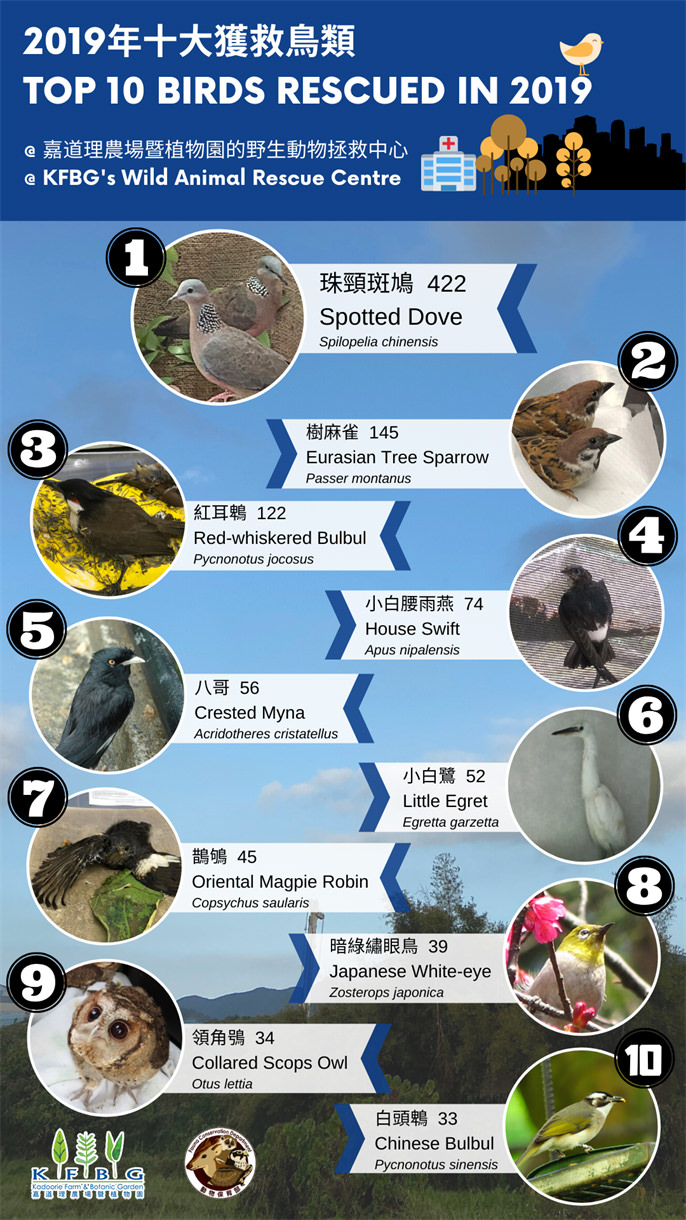Presenting the top 10 rescued birds in 2019

This may seem a slightly sad poster as all the bird species depicted required life-saving assistance. Birds are rescued for various reasons many of which are related to man-made structures or activities. The poster does, however, provide an interesting insight into which bird species commonly appear at the KFBG Wild Animal Rescue Centre (Rescue Centre) which rescued 1,465 wild birds in 2019 with the help of our key partners the SPCA and AFCD.
Our avian patients receive a comprehensive health check upon arrival, which helps to decide the course of medical treatments to follow and the appropriate pre-release care required. Each bird is cared for by our veterinarians and rescue team. Staff work tirelessly throughout the year to provide the best care for all rescued animals to ensure they have the best chance of survival and increased options for wild release.
What are the top 5 human-related reasons causing these birds to become patients?
1. Physical collision
Many common birds and migratory birds were injured by flying into buildings or glass structures. The reflective surface and the transparency of windows makes it difficult for the birds to detect the hard surface when flying at high speeds. Here are some actions that can be followed to mitigate this problem.
2. Glue traps
Sticky traps are one of the cruellest and most indiscriminate methods of rodent control and cause prolonged suffering to all wild animals that get trapped by these devices. In this graphic, the Tree Sparrow, Red-whiskered Bulbul and Magpie Robin are commonly glue-trapped birds. Read more in this blog post:
3. Nestlings
Some baby birds are mistaken as "birds in need". Please follow this baby bird flowchart to decide what type of action to take when you spot a baby bird on the ground.
4. Cat attacks
We have seen many cases of Spotted Doves having injuries that suggest they are the victims of cat attacks. Cats are natural-born predators and instinctively attack smaller animals such as birds, rodents, and lizards. Owners are responsible for the actions of their pets and should keep them indoors if they have a habit of predating on wildlife.
5. Road injuries
Other birds such as raptors are not quick enough to react to moving vehicles when chasing prey on busy roads and highways and end up as victims themselves.
This is also a reminder that all wild birds including their nests and eggs are protected by the Wild Animal Protection Ordinance (Cap 170) in Hong Kong. Any person who takes, removes, injures, destroys, or willfully disturbs birds, their nest, or their eggs shall be liable to a HKD$100,000 fine and one year imprisonment upon conviction.
If you see a wild bird that is clearly injured or in an unsafe environment, please contact the SPCA at 27111000, AFCD at 1823 or KFBG at 2483 7136 / fauna@kfbg.org for further assistance.

